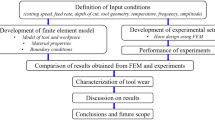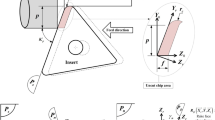Abstract
This paper summarizes the results of thermal finite element simulation and experimental studies of tool temperature in ultrasonic-assisted turning (UAT) of aerospace aluminum using multicoated carbide inserts. At first, mathematical models were developed in order to study the effects of tool coating, rake angle, cutting speed, and feed rate on the friction coefficient. Then with respect to the kinematics of the process, the cutting velocity model would be presented. This velocity model is used in combination with the mathematical model to define the friction coefficient during UAT. The mentioned frictional model is used to write a user subroutine to incorporate the effect of friction coefficient as a function of cutting parameters in the finite element program Abaqus. The results of this simulation make it possible to determine cutting temperature patterns accurately. It is also used to study the effect of cutting parameters (cutting speed, feed rate, rake angle, and vibration amplitude) on UAT. Finally, the simulation results are compared with experimental measurements of cutting temperatures from ultrasonic-assisted turning tests. The results show that ultrasonic-assisted turning is able to lower the maximum cutting temperature in cutting tool, about 29 %, in low feed rates (≈0.14 mm/rev), with a vibration amplitude of ≈10 μm and work velocity of ≈0.5 m/s.
Similar content being viewed by others
References
Brehl DE, Dow TA (2008) Review of vibration-assisted machining. Precis Eng 32:153–172
Klocke F, Dambon O, Bulla B (2008) Ultrasonic assisted diamond turning of hardened steel with mono-crystalline diamond. EUSPEN Anniversary International Conference, In
Liu XD, Ding X, Lee LC, Fang FZ, Lim GC (2003) Direct single point diamond cutting of stavax assisted with ultrasonic vibration to produce optical quality surface finish. In: ASPE Proceedings 2003 Annual Meeting, 67–70.
Moriwaki T, Shamoto E (1995) Ultrasonic elliptical vibration cutting. CIRP Ann 44(1):31–34
Mitrofanov AV, Babitsky VI, Silberschmidt VV (2003) Finite element simulations of ultrasonically assisted turning. Comput Mater Sci 28:645–653
Mitrofanov AV, Babitsky VI, Silberschmidt VV (2004) Finite element analysis of ultrasonically assisted turning of Inconel 718. J Mater Process Technol 233–239
Ahmed N, Mitrofanov AV, Babitsky VI, Silberschmidt VV (2007) 3D finite element analysis of ultrasonically assisted turning. Comput Mater Sci 39:149–154
Amini S, Soleimanimehr H, Nategh MJ, Abudollah A, Sadeghi MH (2008) FEM analysis of ultrasonic-vibration-assisted turning and the vibratory tool. J Mater Process Technol 43–47
Overcash JL, Cuttino JF (2009) In process modeling of dynamic tool-tip temperatures of a tunable vibration turning device operating at ultrasonic frequencies. Precis Eng 33:505–515
Muhammad R, Ahmed N, Roy A, Silberschmidt VV, (2012) Numerical modeling of vibration-assisted turning of Ti-15333. 5th CIRP Conference on High Performance Cutting, 364–369.
Maranhao C, Davim JP (2012) The role of flow stress and friction coefficient in fem analysis of machining: a review. Adv Mater Sci 30:184–188
Riahi E, Ramaswamy HS (2004) High pressure inactivation kinetics of amylase in apple juice. J Food Eng 64:151–160
Khuri AI, Mukhopadhyay S (2010) Response surface methodology. WIREs Comput Stat 2:128–149
Kalhori V, Lundblad M, (2001) Finite element modeling of orthogonal metal cutting. PhD Thesis, Lulea University of Technology.
Haglund AJ, Kishawy HA, Rogers RJ (2008) An exploration of friction models for the chip–tool interface using an Arbitrary Lagrangian–Eulerian finite element model. Wear 265:452–460
Brar N, (2009) Constitutive model constants for Al7075-T651 and Al7075-T6. Meeting of the American Physical Society.
Ucun I, Aslantas K, (2010) Numerical simulation of orthogonal machining process using multilayer and single-layer coated tools. Springer-Verlag London Limited 54 (9), 899–910
Fang N, Wu Q (2005) The effects of chamfered and honed tool edge geometry in machining of three aluminum alloys. J Mach Tools Manuf 45:1178–1187
Author information
Authors and Affiliations
Corresponding author
Rights and permissions
About this article
Cite this article
Khajehzadeh, M., Akhlaghi, M. & Razfar, M.R. Finite element simulation and experimental investigation of tool temperature during ultrasonically assisted turning of aerospace aluminum using multicoated carbide inserts. Int J Adv Manuf Technol 75, 1163–1175 (2014). https://doi.org/10.1007/s00170-014-6163-2
Received:
Accepted:
Published:
Issue Date:
DOI: https://doi.org/10.1007/s00170-014-6163-2




